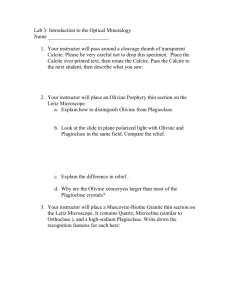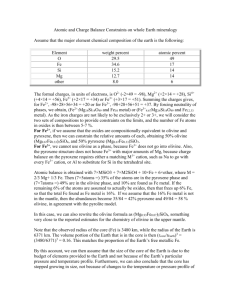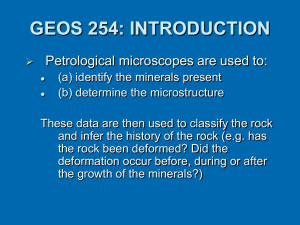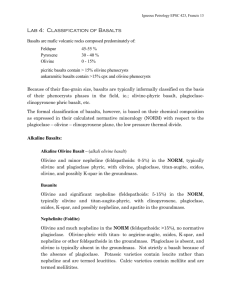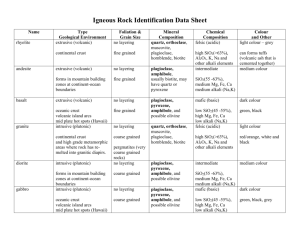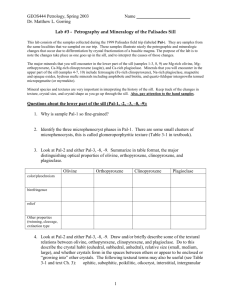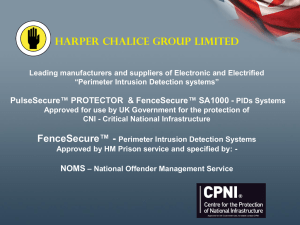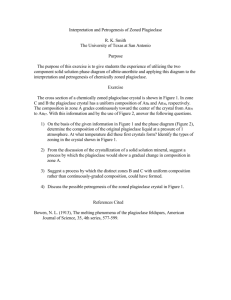Skaergaard Petrographic Suite
advertisement
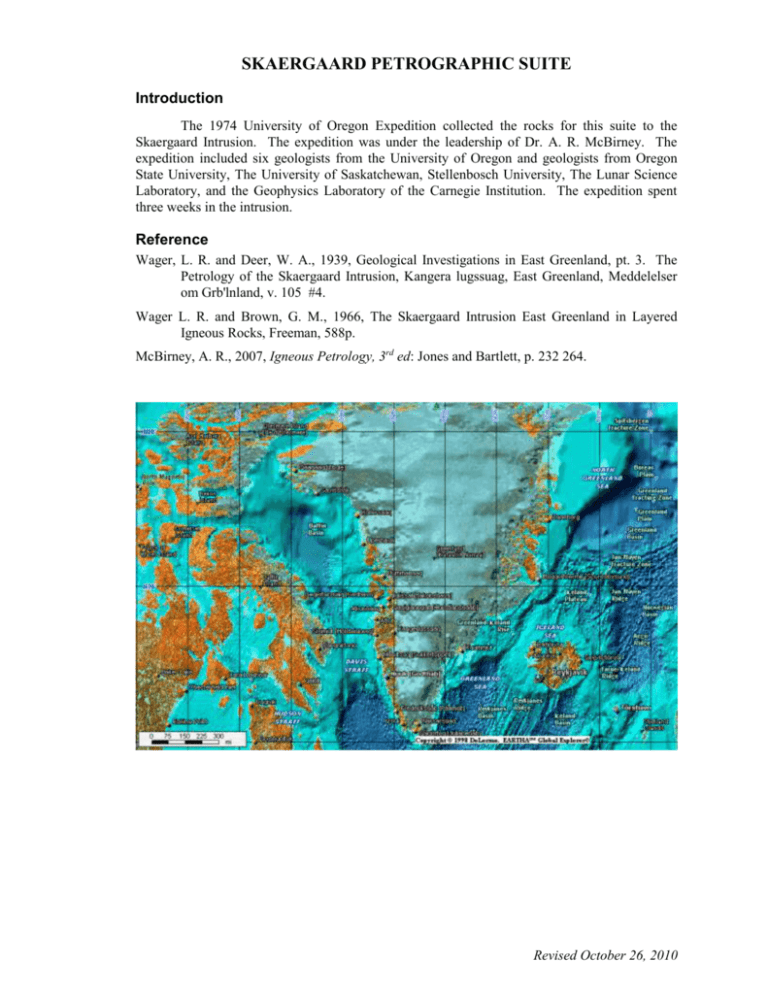
SKAERGAARD PETROGRAPHIC SUITE Introduction The 1974 University of Oregon Expedition collected the rocks for this suite to the Skaergaard Intrusion. The expedition was under the leadership of Dr. A. R. McBirney. The expedition included six geologists from the University of Oregon and geologists from Oregon State University, The University of Saskatchewan, Stellenbosch University, The Lunar Science Laboratory, and the Geophysics Laboratory of the Carnegie Institution. The expedition spent three weeks in the intrusion. Reference Wager, L. R. and Deer, W. A., 1939, Geological Investigations in East Greenland, pt. 3. The Petrology of the Skaergaard Intrusion, Kangera lugssuag, East Greenland, Meddelelser om Grb'lnland, v. 105 #4. Wager L. R. and Brown, G. M., 1966, The Skaergaard Intrusion East Greenland in Layered Igneous Rocks, Freeman, 588p. McBirney, A. R., 2007, Igneous Petrology, 3rd ed: Jones and Bartlett, p. 232 264. Revised October 26, 2010 Skaergaard Intrusion Maps and Cross Sections Figure 1. Simplified map of the Skaergaard intrusion. Units of the Layered Series are Lower Zone (LZ) a, b, and c; Middle Zone (MZ); and Upper Zone (UZ) a, b, and c. The Marginal Border Series (MBS) and Upper Border Series (UBS) merge in the southern part of the map and are not shown separately (from McBirney, A. R., 1993, Figure 6-21. 3 Skaergaard Intrusion 4 Figure 2. Cross section from A to B of Figure 1. Figure 3. Schematic north-south section through the Skaergaard intrusion showing its inferred original form before tilting and erosion. The line of present sea level indicates the amount of flexure toward the south. The crosshatched pattern indicates a later intrusion known as the Basistoppen Sheet. The structure and topography above the present surface is inferred from the estimated original depth of the intrusion and its relationship to contemporaneous volcanic rocks. The root zone is constructed from geophysical data (from McBirney, A. R., 1993, Figure 6-22, a). Skaergaard Intrusion 5 Figure 4. Simplified east-west section through the Skaergaard intrusion at its present level of exposure. View is toward the south looking down dip (from McBirney, A. R., 1993, Figure 622, b). Skaergaard Intrusion Figure 5. Stratigraphic column of the Skaergaard intrusion (from McBirney, A. R., 1993, Figure 6-24). 6 Skaergaard Intrusion 7 Figure 6. Location map of Western Minerals samples (Oregon Numbers). Numbers refer to Western Minerals field numbers. Skaergaard Intrusion 8 Sample Descriptions The first number refers to the UNI collection number. The second number refers to the sample site on the sketch map (Figure 6). UNI-118 (Oregon No. 7): Chilled Margin. This fine grained basalt formed when the Skaergaard magma was chilled against the country rock as it was intruded. This rock contains uniformly sized grains of olivine, plagioclase, magnetite, and clinopyroxene. This sample was collected along the northwest margin of the intrusion on the north side of Uttentals Sund. UNI-119 (Oregon No. 8): Gabbro Picrite. This sample is a medium grained olivine rich gabbro contained as blocks in the marginal zone of the intrusion along its northern contact. The rock contains abundant euhedral olivine crystals in a matrix of plagioclase, magnetite, and poikelitic pyroxene. The olivine is Fo81 and is the most magnesium rich in the intrusion. This sample was collected from the marginal border group on Uttentals Plateau. UNI-120 (Oregon No. 4): Perpendicular Feldspar Rock. This sample is composed of a medium grained olivine gabbro containing elongated feldspar crystals. The plagioclase crystals contain cores of An72 and rims of An77 and are elongated parallel to their c axis. These plagioclase crystals grew perpendicular to the intrusion contact in what is called the tranquil division of the marginal border group. The groundmass contains euhedral to subhedral crystals of olivine, plagioclase, magnetite, and orthopyroxene, enclosed in poikelitic crystals of clinopyroxene. This sample was collected approximately 30 meters east of the western margin of the intrusion on Mellamo Island. UNI-121 (Oregon No. 5): Course Clot Material. This sample is a coarsely crystalline olivine gabbro from the marginal border zone of the intrusion. It is composed of large intergrown crystals of plagioclase and clinopyroxene with included euhedral crystals of olivine and anhedral magnetite. These clot bands which occur at irregular intervals within the Marginal Border Group are often partially altered to chlorite minerals. This sample was collected approximately 50 meters from the intrusion margin on Mellamo Island. UNI-122 (Oregon No. 9): Lower Zone A. This sample is an olivine gabbro containing cumulate olivine and plagioclase in a matrix of intercumulate poikelitic clinopyroxene and accessory magnetite. This sample was collected along Uttentals Sund in the northwest corner of the intrusion. UNI-123 (Oregon No. 10): Lower Zone B. This sample is an olivine gabbro with cumulate olivine, plagioclase, and clinopyroxene in a matrix of poikelitic clinopyroxene and minor amounts of magnetite. It was collected along the northern shore of Uttentals Sund at the site of the 1965 drilling attempt of the Skaergaard intrusion. UNI-124 (Oregon No. 11): Lower Zone C. This sample is an olivine gabbro with cumulate olivine, plagioclase, clinopyroxene, and magnetite with intercumulate poikelitic clinopyroxene and abundant anhedral magnetite. This sample was collected from the eastern edge of Kramers Island. UNI-125 (Oregon No. 25): Middle Zone. This sample is a course-grained gabbro with cumulate clinopyroxene, plagioclase, and magnetite. Interstitial minerals include clinopyroxene and magnetite. Olivine is generally absent from this zone but rare crystals do exist. This sample was collected from the southeast corner of Krammers Island. UNI-126 (Oregon No. 23): Upper Zone A. This sample is a ferrodiorite with cumulate olivine, plagioclase, clinopyroxene, and magnetite. The intercumulate material is primarily poikelitic clinopyroxene and anhedral magnetite. This sample was collected .5 kilometers south of Forbindels glacier along Uttentals Sund. Skaergaard Intrusion 9 UNI-127 (Oregon No. 21): Upper Zone B. This sample is a ferrodiorite with cumulate olivine, plagioclase, clinopyroxene, and apatite. Intercumulate minerals include plagioclase, clinopyroxene, and magnetite. This sample was collected from the south side of Home Bay. UNI-128 (Oregon No. 26): Upper Zone C. This sample is a ferrogabbro containing cumulate olivine, plagioclase, magnetite, and apatite. The original intercumulate wollastonite has been inverted to a patchy pyroxene during cooling. Collected along Skaergaard bay near the foot of Basisglacier. UNI-129 (Oregon No. 28): Sandwich Horizon. This sample is a ferrogabbro containing cumulate crystals of olivine, plagioclase, apatite, and inverted wollastonite. This horizon also contains dendritic magnetite and myrmekititc quartz. The sandwich horizon represents the final product of the layered series differentiation and is believed to have formed from residual liquids trapped between the layered series and the Upper border group. This sample was collected from the eastern slopes of Baststoppen. UNI-130 (Oregon No. 29): Upper Border Group. This sample is a medium grained plagioclase rich gabbro containing cumulate plagioclase, clinopyroxene, and olivine. Alteration has introduced quartz, chlorite, and zeolite. The rocks of the upper border group are often altered due to their having formed above the cooling Skaergaard magma. This sample was collected approximately ½ kilometer north of the southern margin of the intrusion near the entrance to Skaergaard. UNI-131 (Oregon No. 30): Melano Granophyre. This sample of granophyre contains quartz, plagioclase, orthoclase and abundant magnetite and pyroxene. The quartz forms myrmekitic intergrowths with orthoclase and the pyroxene occurs as long, often dendritic, needles which give the rock a streaky appearance. Melano granophyre bodies occur as disseminated masses in much of the lower portion of the upper border group. This sample was collected from the south side of Basistoppen. UNI-132 (Oregon No. 16): Tinden Sill. This sample is an acid granophyre containing plagioclase, orthoclase and quartz crystals and areas of myrmekitic intergrowths of quartz and orthoclase. This sill represents the most differentiated rock in the Skaergaard complex. This sample was collected from the north side of Tinden Peak near Brodretoppen glacier. UNI-133 (Oregon No. 27): Transgressive Granophyre. This sample is a medium grained granophyre with anhedral crystals of quartz and orthoclase, euhedral crystals of plagioclase, and accessory hornblende and biotite. It comes from one of the many postSkaergaard granophyre dikes that cut through the layered series. This sample was collected ½ kilometer south of Forbindelses glacier along Uttentals Sund. UNI -134 (Oregon No. 2): Unaltered Gneiss. This sample is strongly foliated feldspathic gneiss of Precambrian age. The lighter bands are composed primarily of quartz, orthoclase, and plagioclase while the darker bands are composed of magnetite, clinopyroxene, and quartz with only scattered feldspar crystals. This sample was collected from the western end of Mellamo Island approximately 100 meters from the intrusion. UNI-135 (Oregon No. 1) Contact Altered Gneiss. This sample is recrystallized feldspathic gneiss showing a slight remnant foliation. It is composed primarily of quartz, orthoclase, and plagioclase, and contains as accessory minerals biotite, chlorite, and magnetite. The intrusion is in contact with Precambrian gneiss along its western and northern margins. This sample was collected approximately 1 meter west of the contact on Mellamo Island. Skaergaard Intrusion 10 UNI-136 (Oregon No. 6) Fused Gneiss. This sample comes from a partially melted gneiss block included in the marginal border zone of the intrusion. The rock has a mottled appearance caused by darker bands of Skaergaard material surrounding lighter areas of fused gneiss. The darker bands contain crystals of olivine, plagioclase, magnetite, and clinopyroxene, while the lighter areas are composed of cores of fused gneiss surrounded by lighter reaction rims of euhedral quartz. The rock also contains scattered blebs of chalcopyrite. The sample was collected from the marginal border group on Uttentals Plateau. UNI-137 (Oregon No. 3) Dolerite Dike. This sample was collected from a fine-grained, post Skaergaard, basaltic dike approximately .5 meters in width. Post Skaergaard dikes ranging from a few centimeters to many meters in width are very abundant in the southern portion of the intrusion. This sample was collected on Mellamo Island near the western contact of the intrusion. UNI-138 (Oregon No. 17) Contact Altered Dike. This sample represents a fine grained basalt dike, which has been altered to a granular hornfels by its close proximity to the Skaergaard intrusion. This sample from a pre-Skaergaard Tertiary dike was collected 3 meters south of the southern margin of the intrusion. UNI-139 (Oregon No. 24) Altered Basalt. This sample represents a fine-grained basalt which has been altered to a granular hornfels by the Skaergaard intrusion. It was collected on the east side of the intrusion near Miki's Fiord. UNI-140 (Oregon No. 22) Basistoppen Sheet. This sample is a spotted gabbro containing plagioclase, orthopyroxene, and magnetite. The Basistoppen sheet is a large differentiated basic sill in the southern portion of the intrusion. The mafic minerals in this sill are often altered giving the rock its characteristic mottled or spotted appearance. This sample was collected from Skillenunatak along Skaergaard Bay. UNI-141 Basalt, Tertiary plateau type, Skaergaard Bay. Skaergaard Intrusion 11 Thin Section Descriptions The first number refers to the UNI collection number and the following letter refers to the reference number of Western Minerals. UNI-118 (Western Minerals L). Chilled Margin - Close to the contact, the chilled margin rocks have a fine-grained granular texture and commonly may not be present depending on the amount of assimilation of silica from the wall rocks. Small fragments of gneiss commonly occur as xenoliths or xenocrysts. UNI-119 (Western Minerals M). Gabbro Picrite - This particular rock is closer to a feldspathic peridotite than a gabbro but the name applied by Wager is widely accepted. Blocks of this composition are found near the margin of the intrusion along the northern boundary where the lowest levels of the intrusion are exposed. The olivine is the most Mg-rich in the intrusion. Presumably the blocks were carried up to their present level from a deeper horizon, perhaps in the feeding channel. UNI-120 (Western Minerals N). Perpendicular Feldspar Rock - The marginal border group contains slender plagioclase crystals that are oriented normal to the contact and give the rock a comb or crescumulate texture. Small olivines and poikilitic pyroxene occur between the elongated feldspar crystals. UNI-121 (Western Minerals 0). Pegmatoidal Material - The marginal border group contains bands and clots to coarsely crystalline rock. Although the exact mechanism for their formation is unknown, they are believed to have formed from volatile-rich liquids. They contain large crystals of olivine, plagioclase, pyroxene, and apatite and together with biotite, calcite, quartz, sphene, and alteration products. The biotite is now largely altered to chlorite. UNI-122 (Western Minerals A). Lower Zone A - Olivine (Fo65) and labradorite form large granular crystals surrounded by poikilitic pyroxene. Magnetite occurs as an accessory mineral that crystallized from the trapped intercumulate liquid. Biotite has formed between magnetite and plagioclase as a result of reaction with volatiles escaping from the underlying gneiss. UNI-123 (Western Minerals B). Lower Zone B - Olivine, labradorite, augite, and inverted pigeonite are cumulus phases at this level. Poikilitic pyroxene and accessory magnetite fill in the intercumulate areas. Note the exsolution textures of the pyroxenes. UNI-124 (Western Minerals C). Lower Zone C - Magnetite is abundant at all levels above the base of this zone. Note the reaction rims between magnetite and pyroxene; this is thought to be the result of sub-solidus reduction of the magnetite and desilication of adjacent pyroxene to produce an iron-rich olivine. Feathery intergrowths of pyroxene and spinel formed near the edges of some of the plagioclase, possibly as a result of locally concentrated water, which favored a shift of the plagioclase to a more albitic composition. The plagioclase is well oriented. UNI-125 (Western Minerals D). Middle Zone - At this level olivine ceased to crystallize as a primary phase but is still present in small amounts due to late reactions between magnetite and pyroxene. Plagioclase is now about An5 and the pyroxene is intermediate between iron and magnesium end members1. UNI-126 (Western Minerals E). Upper Zone A - Olivine (hortonalite) reappears as a cumulus phase at the base of the upper zone and becomes increasingly iron rich upward. The pyroxenes have a brownish color and a high refractive index because of their high iron content. 1 This may be a typographical error in the Western Minerals’ descriptions. A composition of An50 would be more expected. Skaergaard Intrusion 12 UNI-127 (Western Minerals F). Upper Zone B - About 100 meters above the base of the upper zone apatite becomes a cumulate mineral. This rock contains about 2.7% P 205. Olivine and pyroxene are very iron rich and when oxidized exsolve magnetite along fractures. UNI-128 (Western Minerals G). Upper Zone C - Near the top of the upper zones the pyroxenes are almost pure hedenbergite. They crystallized initially as Fe-wollastonite but on cooling entered the stability range of clinopyroxene. The greenish patchy pyroxenes are typical of inverted Fe-wollastonite, while the brown optically continuous pyroxenes have grown entirely as clinopyroxene. The olivine is essentially pure fayalite, but the plagioclase is still only andesine. Scattered patches of granophyre have crystallized from the trapped liquid. UNI-129 (Western Minerals H). Sandwich Horizon - This is thought to be the last rock to crystallize as the layered sequences of the roof and the floor converged. The olivine is nearly pure fayalite and the pyroxene pure hedenbergite. The rock is rich in residual components, including high concentrations of excluded trace elements. Note that the silica mineral crystallized originally as quartz. UNI-130 I (Western Minerals I). Upper Border Group - The last of the rocks of the upper border group that crystallized from the roof downward have many of the features of the main layered series, but tend to be richer in plagioclase and to have been hydrotherrmally altered by gases that streamed up through them. This rock which comes from just above the sandwich horizon crystallized tridymite as the initial silica phase, but crystallized quartz as the rock cooled. The needle-like quartz crystals are pseudomorphs of tridymite. The tridymite - quartz transition occurred at about 980ºC at this pressure level. UNI-130 J (Western Minerals J). Upper Border Group This section shows the type of alteration typical of much of the upper border group. Chlorite, epidote, and zeolite are the typical alteration minerals. Note the two types of granophyric intergrowths. During early stages of crystallization the silica mineral, tridymite, forms long slender intergrowths with feldspar, but below the transition to quartz the texture became more myrmekitic. UNI-130 K (Western Minerals K). Upper Border Group - The highest levels of the upper border group contain large laths of labradorite with a composition close to those of the lowest exposed part of the layered series. Poikilitic pyroxene has grown between the plagioclase laths and comprises a large portion of the rock. Graphic magnetite crystals and rare interstitial quartz crystallized from the trapped liquid. UNI-131 (Western Minerals P). Melanogranophyre - This rock, originally called a hedenbergite granophyre by Wager, has a coarse graphic texture with perthitic alkali feldspars and iron-rich pyroxene. The melanogranophyre occurs as isolated bodies within the upper border group and is believed to represent a miscible liquid which separated from the main Skaergaard magma at a late stage in its differentiation history. UNI-132 (Western Minerals R). Tinden Sill - This granophyre forms a large sill intruded into the upper part of the Skaergaard intrusion and is the most differentiated rock in the complex. Strontium isotope studies indicate that this sill is the product of melting of the surrounding gneiss. The granophyre consists almost entirely of alkali feldspar and quartz. UNI-133 (Western Minerals Q). Transgressive Granophyre - Transgressive granophyres occur within the layered series and upper border group as dikes and sills. They are composed primarily of quartz, orthoclase, and plagioclase, hornblende and biotite. UNI-134 (Western Minerals T). Foliated Gneiss - This specimen of foliated feldspathic gneiss was collected 100 meters from the intrusion contact. It consists of a mosaic of quartz and feldspar with biotite and granular aggregates of hypersthene and magnetite. Some of the plagioclase has clear untwinned rims surrounding a cloudy interior. Skaergaard Intrusion 13 UNI-135 (Western Minerals S). Contact Gneiss - This sample collected less than 1 meter from the contact is surprisingly unaltered. Although there has been some recrystallization there is still a remnant foliation. The minerals include quartz, cloudy feldspar, biotite, chlorite, epidote, and magnetite. UNI-136 (Western Minerals U). Fused Gneiss – This sample comes froma partially melted lock of gneiss included in the margin border zone of the initrusion. The darker bands contain olivine, plagioclase, magnetite, and clinopyroxenne. The lighter bands contain a larger proportion of plagioclase and accessory biotite and clinozoisite. The lighter areas represent partially fused gneiss and the darker areas the Skaergaard magma. Most of the original quartz has been consumed in reaction with the olivine gabbro. UNI-137 (Western Minerals V). Basaltic Dike – This rock originally contained microphenocrysts of augite, plagioclase, and olivine in a intergranular groundmass of plagioclse, pyroxene, magnetite, and glass. The rock has been hydrothermally altered so that the olivine has been reduced and pseudomorphed by serpentine, and the glassy groundmass has been devirtified. UNI-139 (Western Minerals W). Altered Basalt – This sample represents an altered basalt that was in contact with the Skaergaard intrusion. It contains rounded aggregates of coarse pyroxene in a fine grained matrix of granular pyroxene and anhedral platioclase. Olivine has broken down completely and magnetite has recrystalized to elongated blebs and irregular clots. Secondary biotite is intimately associated with the magnetite and apatite is an abundant accessory mineral. UNI-140 (Western Minerals X). Basistoppen Sheet – The Basistoppen sheet is a large sill (400 meters thick) which has been intruded into the upper portion of the Skaregaard intrusion. This sample contains orthopyroxene and clinopyroxene both of which are partialllly altered to chlorite. Other minerals include plagioclse and graphic magnetite. Although this sill is believed to be later than the Sikaergaard intrusion it tends to be more altered. The alteration of the mafic minerals in this rock gives it a characteristic spotted appearance. Skaergaard Intrusion 14 Sample Number UNI-118 UNI-119 UNI-120 UNI-121 UNI-122 UNI-123 UNI-124 UNI-125 UNI-126 UNI-127 UNI-128 UNI-129 UNI-130 UNI-131 UNI-132 UNI-133 UNI-134 UNI-135 UNI-136 UNI-137 UNI-138 UNI-139 UNI-140 SiO2 TiO2 Al2O3 Fe2O3 48.67 39.57 47.23 48.2 45.48 47.93 41.05 42.16 44.44 37.06 43.46 55.1 55.3 58.81 75.03 71.56 68.17 70.37 59.58 47.61 43.17 47.89 49.17 0.56 0.37 0.4 0.4 1.31 1.3 4.83 6.07 5.28 5.55 3.0 1.16 0.94 1.26 0.31 0.44 0.63 0.65 0.89 1.58 3.75 1.74 2.2 17.37 1.61 16.7 19.18 13.8 16.31 10.2 10.21 11.22 10.41 7.41 9.9 18.52 12.02 13.71 15.63 16.13 15.37 15.1 10.92 9.26 14.36 11.23 2.19 0.44 0.65 1.33 0.49 1.36 5.63 4.8 4.18 4.05 3.06 4.75 2.18 5.77 1.56 0.76 0.58 0.47 0.52 3.8 2.23 1.63 4.19 FeO 5.75 17.77 8.6 7.4 12.94 9.65 16.06 14.89 16.54 20.41 28.07 15.14 7.47 9.38 0.58 2.14 2.09 2.52 7.31 7.25 11.68 10.14 17.28 MnO MgO CaO Na2O 0.13 0.24 0.13 0.13 0.17 0.16 0.23 0.24 0.28 0.5 0.28 0.14 0.08 0.21 0.01 0.03 0.05 0.05 0.1 0.19 0.22 0.19 0.33 8.16 37.59 11.13 8.47 13.26 8.88 8.46 7.12 4.79 5.69 0.21 0.13 0.21 0.72 0.15 0.43 1.82 1.52 5.38 13.49 15.08 7.28 1.28 12.65 1.12 12.88 11.7 8.71 10.24 10.38 10.91 8.67 9.72 9.73 7.76 8.2 5.03 0.69 0.31 2.07 1.89 4.21 8.07 9.28 10.51 7.62 2.26 0.26 1.86 2.72 2.49 2.39 2.18 2.31 2.91 2.73 2.31 3.86 4.51 3.87 4.24 5.01 4.4 4.11 3.26 2.74 1.5 3.01 3.62 K2O 0.11 0.05 0.07 0.15 0.29 0.24 0.17 0.2 0.24 0.27 0.41 1 1.3 2.25 3.85 3.22 3.22 2.85 1.98 0.1 0.27 0.22 0.81 H2O+ H2O- P2O5 TOTAL 0.96 0.95 0.35 0.27 0.75 0.74 0.58 0.54 1.83 0.41 1.35 0.92 0.41 0.21 0.28 0.3 0.4 0.39 1.17 3.62 0.8 2.76 1.47 0.2 0.02 0.07 0.17 0.06 0.14 0.28 0.07 0.11 0.18 0.2 0.19 0.14 0.19 0.13 0.05 0.16 0.15 0.13 0.58 0.1 0.1 0.11 0.02 0.03 0.04 0.05 0.14 0.09 0.05 0.02 0.14 2.67 0.86 0.24 0.42 0.71 0.03 0.07 0.31 0.29 0.2 0.17 0.1 0.18 0.78 99.48 100.07 100.1 100.17 99.85 99.35 99.79 99.75 100.59 99.58 100.33 100.3 99.61 100.43 100.03 99.9 100.03 100.63 99.83 100.12 99.59 100.01 100.19 Revised October 26, 2010 Hutton Thin Section Collection 206 – Basic xenolith, Border Group, Kraemerso, Greenland, W & D 4136, p. 201 207 – Perpendicular feldspar rock, Mallemo, Greenland, W & D 1849, p. 144 208 – Hypersthene olivine gabbro. Foot N.W. ridge gabbro Fjaeld, Greenland, W & D 1708, p. 88 209 – Olivine hypersthene gabbro. E. Greenland, W & D 1109 210 – Olivine hypersthene gabbro, Border Group, Irnarmiut, Greenland, W & D 4288, p. 154 211 – Olivine hypersthene gabbro. Mallemo, Greenland, W & D 1837, p. 157 212 – Ferrogabbro, Greenland, W & D 2574 213 – Fayalite- ferro-gabbro. W. face of Basistoppen, Greenland, W & D 4139, p. 113, 115 214 – Fayalite ferrogabbro. W. face of Basistoppen, Greenland, W & D 4143, p. 110-2 215 – Olivine rich gabbro, Greenland, W & D 1710 216 – Hybrid, Mellemo, W. Border, Greenland, W & D 1249 217 – Lower Middle gabbro, Uttentals Sound, Greenland, W & D 1691, p. 85, 95 218 – Basic xenolith, outer border group, Kramerso 219 – Hortonolite ferrogabbro, Greenland, W & D 2584, p. 196 220 – Fayalite ferrogabbro (unlayered) purple band, west face Basistoppen, Greenland, W & D 4139, p. 112, 117, & 73 221 – Hypersthene olivine gabbro, Uttentals Plateau, Greenland, W & D 4084, p. 71, 88 222 – Middle gabbro, Greenland, W & D 2122 223 – Basic xenolith in outer border group, Kramers O, W & D 345, p. 201 224 – Olivine gabbro, Udloberen, Greenland, W & D 1827, p. 164 225 – Fayalite ferrogabbro with inverted beta Wollastonite, Basistoppen, Greenland, W & D 4143, p. 110 226 – Granophyre, S.E. slope of Uttenals Plateau, Greenland, (in layered series) W & D 4074, p. 185 227 – Hedebergite andesinite, W. face of Basistoppen, 250 m above “purple band”, Kangerdlugssang, W & D No. 4136, p. 70, 77, 85, 113-6 228 – Hybrid, centre of Mellemo, Kangerdlugssang, W & D No. 1858, p. 156 229 – Granophyre in Border Group, Brodretoppen, Greenland, W & D No. 3045, p. 205 230 – Banded gabbro, layered series, near Basishusene, Uttentals Sound, Greenland, W & D No. 2573 231 – Fayalite ferrogabbro, unlaminated layered series, W. face of Basistoppen, Kangerdlugssang. W & D No. 4139, p. 68, 70, 73, 85, 112-7 232 – Hypersthene olivine gabbro, Kraemers O, Kangerdlugssang, W & D No. 2308, p. 97 233 – Olivine gabbro, S. margin Border Group, zoom from outer contact, foot of W. ridge of Tinden, Kangerdlugssang, W & D No. 2775 234 – Olivine gabbro, foot of Tinden, Kangerdlugssang, W & D No. 1225, c.f., p. 209-11 235 – Granophyre, Uttentals Sound, Kangerdlugssang, W & D No. 2562, p. 206 236 – Hybrid, near Basishusene, Kangerlugssang, W & D No. 2584, p. 187 237 – Hortonolite, ferrogabbro, near Main Base House, Kangerdlugssang, W & D No. 2569, p. 119 238 – Gabbro, Skaergaard Intrusion, E. Greenland. Exact location unknown Revised October 26, 2010 Skaergaard Intrusion 18 Kodachrome slides. Group 1. Kodachrome slides illustrating field relations. 1. View of the basaltic lavas and dikes on the south and east sides of the intrusion. Ship gives scale of relief. 2. View looking northeast with basalts on the right overlying Precambrian gneisses and amphibolites on the left. 3. View from the central part of the intrusion looking west. The contact between the Gabbro and gneiss in clearly visible on Kraemer’s Island across the fjord. 4. View looking south and up section. The entire layered series and most of the upper border group can be seen starting with LZa in the foregound. The large glacier is near the boundary between MZ and Uza. 5. Gneiss contact on the east side of Uttentals Sound. The light brown gabbros are LZa and LZb and the change to darker colors mark the base of LZc where magnetite becomes abundant. 6. Chilled margin again gneiss. 7. Inclusions of wall rocks in the marginal gabbro. 8. Closer view of block gneiss showing rim melting and reaction with the surrounding gabbro. 9. Acicular plagioclase and pyroxene in the tranquil zone of the marginal border group. 10. Blocks of ‘gabbro picrite’ in the marginal border group on Uttentals Plateau. 11. Banded division of the marginal border group on Mellemo Island. 12. Contact between the layered series on the left and marginal border group on the right. Note the sharp angular discordance between the steeply dipping marginal border group and the more nearly horizontal layered series. 13. Cross bedding in LZa just above the basal contact and near the wall. 14. Same. Note the fine banding between the more prominent darker layers. 15. Typical outcrop of LZa on Uttentals Plateau. 16. Typical outcrop of LZ showing contact between LZb (light colored) and LZc (dark colored) rocks. Man is standing just beyond the contact on LZb. 17. Zone of Abundant xenoliths in LZb. Blocks are thought to have come from the roof. 18. Strongly layered gabbro of LZb. Note folds produced by sliding of one layer over the other. 19. View of Gabbro Peak from the north with rocks of MZ in foreground. 20. View of the west face of Wager Peak showing strong layering and large blocks, presumably pieces of the Upper Border Group that sank from the roof. Skaergaard Intrusion 19 21. Closer view of the same face showing layering draped over a large block. Block is the size of a large house. 22. Upper part of MZ in same face showing the conspicuous Triple Group. 23. Block in MZ. 24. Rhythmic layering. 25. View of the upper part of the intrusion looking across Forbindels Glacier from the north. Sandwich Horizon is just above the level of the two nunataks. 26. View of the southern part of the intrusion including UZ and the Upper Border Group. 27. Discontinuous layering in UZa. A transgressive granophyre can be seen in the upper part of the outcrop. 28. Trough Band in UZa. Plunge of the axis of the trough can be followed to the crest of the ridge and down to the bay in the background. 29. Closer view of layering in a trough band. Outcrop was defaced by members of an earlier expedition. The origin of the troughs is still uncertain. The explanation offered by Wager held that they resulted from deposition from turbidity currents flowing down the axis of the trough, but the detailed structures do not all agree with this explanation. 30. Clots of granophyric material in UZc. In contrast with the granophyre produced by melting of gneiss inclusions, these are thought to be segregations of a second immiscible liquid. 31. Sandwich Horizon. Darker rocks below are UZc, lighter ones above are the lowermost part of the Upper Border Group. The Sandwich Horizon is a patchy Zone between the two units crystallizing from the top down and the bottom up. 32. Small body of granophyre in the Upper Border Group. 33. Larger granophyre in Upper Border Group. Note the later dikes. Skaergaard Intrusion 20 Group 2. Kodachrome slides including maps, cross-sections, and relatives found in the thin sections. 34. Map of Greenland. Skaergaard is located at 68N on the east coast where the Precambrian rocks on the south meet the Eocene basalts on the north. 35. Map and cross-sections through the intrusion. 36. Hypothetical reconstruction of the original form of the intrusion. 37. Stratigraphic section of the intrusion. 38. Texture of chilled margin in this section. (See slide #6) 39. Thin section of gabbro picrite showing well-developed orthocumulate texture. 40. Thin section of gabbro from LZa showing characteristic poikilitic augite. (See LZa outcrop 15) 41. Thin section of gabbro from LZb. Augite forms grains with about the same size and form as the plagioclase and olivine. Wager interpreted this as evidence that augite was a primary precipitate in LZb but an interstitial post-cumulate phase in LZa. The difference may simply be due to differing nucleation rates, however. 42. Thin section of gabbro from LZb showing resorption of olivine, which has reacted with the liquid to form pyroxene. 43. Exsolution texture in clinopyroxene caused by separation of Ca-poor pyroxene along (001) planes of the host. 44. Thin section of gabbro from LZc showing abundant magnetite. (See slide #16) 45. Thin section, middle-zone gabbro. Resembles that of LZb, but lacks primary olivine. 46. Thin section of gabbro from UZa. Contains iron-rich olivine. 47. Thin section of gabbro from UZb. Contains large cumulous apatite crystals. 48. Thin section of gabbro from UZc. Patchy texture of pyroxene in the result of inversion from Fe-wollastonite. 49. Specimen from an experimental charge showing immiscible texture between liquids with the composition of UZc and granophyre. (See slide #31) 50. Thin section of specimen from the Sandwich Horizon. (See slide #32) 51. Graphic texture of quartz and feldspar in melanogranophyre from the Upper Border Group. 52. Similar texture but with clinopyroxene. 53. Thin section of granophyre from the Tinden Sill.
